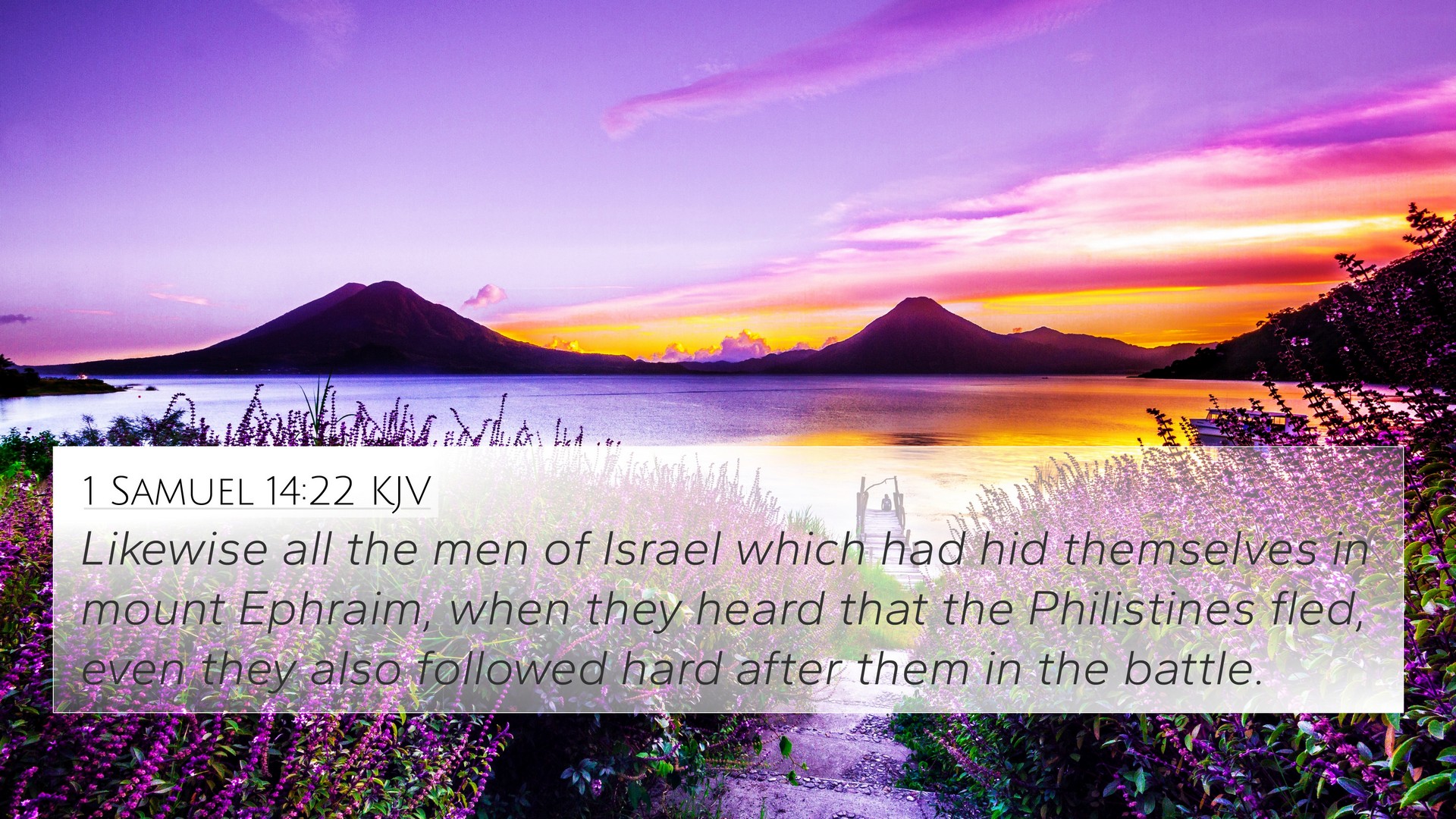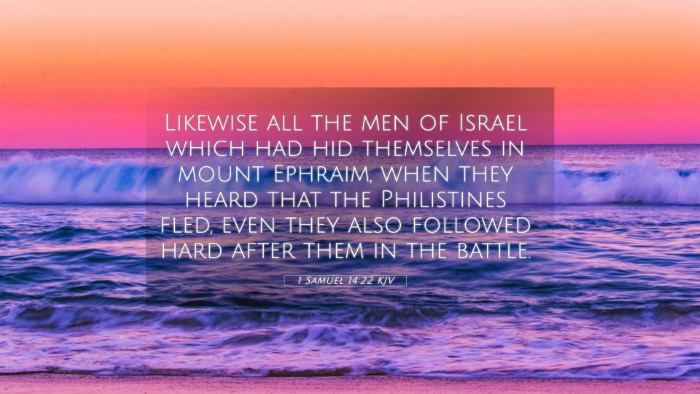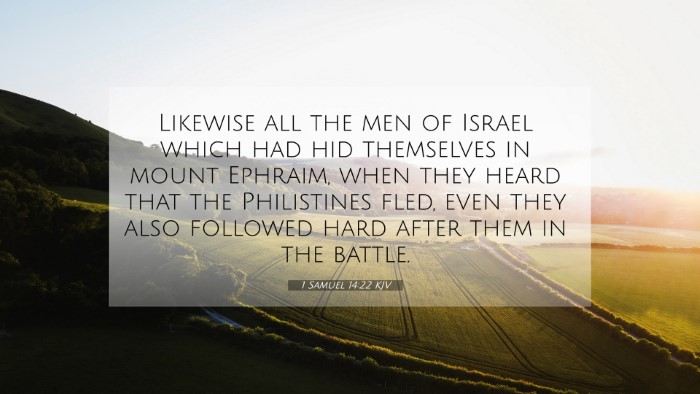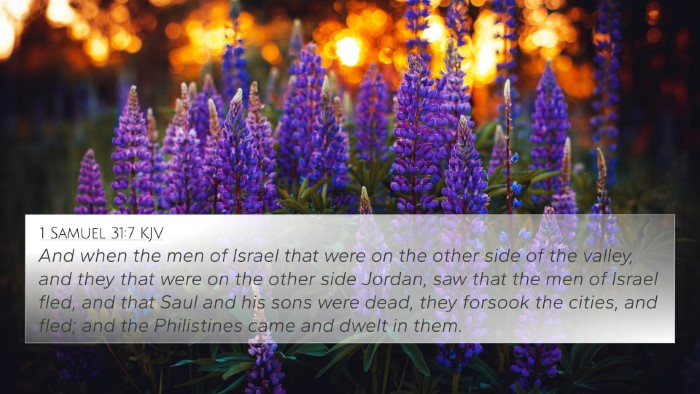Understanding 1 Samuel 14:22
Verse Text: "Likewise, when all the men of Israel who had hidden themselves in the mountains of Ephraim heard that the Philistines fled, they followed hard after them in the battle." (1 Samuel 14:22, NKJV)
Summary of the Verse
This verse speaks about a critical moment in the battle between the Israelites and the Philistines. The men of Israel, who had been fearful and hidden, were galvanized into action upon hearing the news of the Philistines' retreat. Their initial fear turned into courage as they pursued the fleeing enemy, reflecting a transformation in their spirit during the conflict.
Insights from Public Domain Commentaries
-
Matthew Henry:
Henry highlights the dramatic turnaround of the Israelites who had once been consumed by fear. He emphasizes that God's providence encouraged these men to engage in battle, demonstrating that sometimes, victories arise from the unexpected resolve of beleaguered forces.
-
Albert Barnes:
Barnes explains that the fear of the Israelites was alleviated by the sound of victory, leading them to join the fight actively. His commentary suggests that this reflects the broader theme of divine intervention, where God uses fear and retreat to ignite courage in His people.
-
Adam Clarke:
Clarke notes the historical significance of this moment, pointing out how fear can paralyze but also how it can be transformed into action through divine encouragement. He discusses the importance of unity and collective action in overcoming a common enemy, which is a decisive factor in this narrative.
Connections Between Bible Verses
This verse offers numerous connections with other Biblical themes and narratives. Below are cross-referenced verses that share similar themes of courage, divine intervention, and the transformation of fear into action:
- 1 Samuel 10:6-7: Samuel tells Saul about the Spirit of the Lord rushing upon him, highlighting the transformative power of God's Spirit which can change fear into courage.
- Psalm 56:3-4: David speaks about trust in God even in fear, which can be seen as a precursor to Israel's actions in 1 Samuel 14:22.
- Isaiah 41:10: God assures His people not to fear because He is with them, echoing the theme of divine support in times of distress.
- Matthew 28:10: In the New Testament, Jesus tells the disciples not to fear, resembling the same encouragement that leads to collective action.
- 2 Timothy 1:7: Paul affirms that God has given us a spirit not of fear but of power, love, and self-control, showing the transformation urged in 1 Samuel 14:22.
- Joshua 1:9: The command to be strong, and courageous works in parallel with the Israelites overcoming their fears in battle.
- Exodus 14:13-14: Moses instructs the Israelites not to fear as God will fight for them, mirroring God's role in the outcome of this battle.
Thematic Bible Verse Connections
The heart of 1 Samuel 14:22 is about resilience and faith, themes which resonate throughout both the Old and New Testaments. The act of following into battle is symbolic of unity and collective faith in a greater cause, often reflected in the actions of God’s people throughout scripture. Below are additional verses that serve to reinforce this idea:
- Hebrews 11:32-34: The faith of Old Testament figures is celebrated, encouraging the understanding that the experiences of fear and courage are common themes throughout Biblical history.
- Philippians 4:13: "I can do all things through Christ who strengthens me," which embodies the courage found in collective faith and divine support.
- Romans 8:31: "If God is for us, who can be against us?" reinforces the idea that divine support turns the tide of fear into courageous action.
Conclusion
The narrative surrounding 1 Samuel 14:22 provides profound insight into the dynamics of fear and courage in the face of adversity. Through divine intervention and the culmination of collective effort, the Israelites illustrate that faith can indeed turn the tide of battle. This understanding offers a template for interpreting similar struggles and victories throughout scripture.
Tools for Bible Cross-Referencing
For those studying the connections between these verses, several tools can enhance understanding and exploration:
- Bible concordance for locating specific terms and their occurrences across scripture.
- Bible cross-reference guides provide thematic study aids for exploring relationships between verses.
- Comprehensive Bible cross-reference materials enable deeper insights into Biblical narratives and principles.
By engaging in cross-referencing Bible study methods, believers can better interpret scripture and apply its teachings to their lives, identifying connections not only between verses but also within the broader narrative of God's word.




